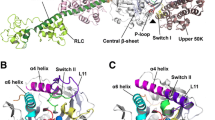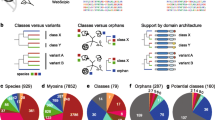Abstract
Recent studies have shown surprising structural and functional similarities between the motor domains of kinesin and myosin. Common features have also been described for motor proteins and G proteins. Despite these similarities, the evolutionary relationships between these proteins, even among the motor proteins, has not been obvious, since the topological connectivities of the core overlapping structural elements in these transducing proteins are not identical to one another. Using secondary structure topology, comparison of functional domains and active site chemistry as criteria for relatedness, we propose a set of rules for determining potential evolutionary relationships between proteins showing little or no sequence identity. These rules were used to explore the evolutionary relationship between kinesin and myosin, as well as between motor proteins and other phosphate-loop (P-loop) containing nucleotide- binding proteins. We demonstrate that kinesin and myosin show significant chemical conservations within and outside of the active site, and present an evolutionary scheme that produces their respective topologies from a hypothetical ancestral protein. We also show that, when compared with various other P-loop-containing proteins, the cytoskeletal motors are most similar to G proteins with respect to topology and active site chemistry. We conclude that kinesin and myosin, and possibly G proteins, are probably directly related via divergent evolution from a common core nucleotide-binding motif, and describe the likely topology of this ancestor. These proteins use similar chemical and physical mechanisms to both sense the state of the nucleotide bound in the active site, and then transmit these changes to protein partners. The different topologies can be accounted for by unique genetic insertions that add to the edge of a progenitor protein structure and do not disrupt the hydrophobic core.
Similar content being viewed by others
References
ABRAHAMS, J. P., LESLIE, A. G., LUTTER, R. & WALKER, J. E. (1994) Structure at 2.8 Å resolution of F1-ATPase from bovine heart mitochondria. Nature 370, 621–8.
ARTYMIUK, P. J., POIRRETTE, A. R., RICE, D. W. & WILLETT, P. (1996) Biotin carboxylase comes into the fold. Nature Struct. Biol. 3, 128–32.
ARTYMIUK, P. J., RICE, D. W., POIRRETTE, A. R. & WILLETT, P. (1995) beta-Glucosyltransferase and phosphorylase reveal their common theme. Nature Struct. Biol. 2, 117–20.
BLOOM, G. & ENDOW, S. (1995) Motor proteins 1: kinesin. Protein Profiles 1, 1112–38.
BORK, P., SANDER, C. & VALENCIA, A. (1992) An ATPase domain common to prokaryotic cell cycle proteins, sugar kinases, actin, and hsp70 heat shock proteins. Proc. Natl Acad. Sci. USA 89, 7290–94.
BRANNIGAN, J. A., DODSON, G., DUGGLEBY, H. J., MOODY, P. C., SMITH, J. L., TOMCHICK, D. R. & MURZIN, A. G. (1995) A protein catalytic framework with an N-terminal nucleophile is capable of self-activation Nature 378, 416–19.
DOOLITTLE, R. F. (1994) Convergent evolution: the need to be explicit. Trends Biochem. Sci. 19, 15–18.
DOOLITTLE, R. F. (1995) The multiplicity of domains in proteins. Ann. Rev. Biochem. 64, 287–314.
DOOLITTLE, R. F. & BORK, P. (1993) Evolutionarily mobile modules in proteins. Sci. Amer. 269, 50–56.
FAN, C., MOEWS, P. C., SHI, Y., WALSH, C. T. & KNOX, J. R. (1995) A common fold for peptide synthetases cleaving ATP to ADP: glutathione synthetase and D-alanine: d-alanine ligase of Escherichia coli. Proc. Natl Acad. Sci. USA 92, 1172–6.
FISHER, A J., SMITH, C. A., THODEN, J. B., SMITH, R., SUTOH, K., HOLDEN, H. M. & RAYMENT, I. (1995) Xray structures of the myosin motor domain of Dictyostelium discoideum complexed with MgADP.BeFx and MgADP.AlF4-. Biochemistry 34, 8960–72.
FLAHERTY, K. M., DELUCA-FLAHERTY, C. & MCKAY, D. B. (1990) Three-dimensional structure of the ATPase fragment of a 70 K heat-shock cognate protein. Nature 346, 623–8.
FLAHERTY, K. M., MCKAY, D. B., KABSCH, W. & HOLMES, K. C. (1991) Similarity of the three-dimensional structures of actin and the ATPase fragment of a 70-kDa heat shock cognate protein. Proc. Natl Acad. Sci. USA 88, 5041–5.
FLORES, T. P., MOSS, D. S. & THORNTON, J. M. (1994) An algorithm for automatically generating protein topology cartoons. Protein Engineering 7, 31–7.
GIBBONS, I. R. (1995) Dynein family of motor proteins: present status and future questions. Cell Motil. Cytoskel. 32, 136–44.
GUPTA, R. S. & GOLDING, G. B. (1993) Evolution of HSP70 gene and its implications regarding relationships between archaebacteria, eubacteria, and eukaryotes. J. Mol. Evol. 37, 573–82.
HOLM, L. & SANDER, C. (1993) Protein structure comparison by alignment of distance matrices. J. Mol. Biol. 233, 123–38.
HOLM, L. & SANDER, C. (1995) Evolutionary link between glycogen phosphorylase and a DNA modifying enzyme. Embo J. 14, 1287–93.
HWANG, P. K. & FLETTERICK, R. J. (1986) Convergent and divergent evolution of regulatory sites in eukaryotic phosphorylases. Nature 324, 80–84.
KULL, F. J., SABLIN, E. P., LAU, R., FLETTERICK, R. J. & VALE, R. D. (1996) Crystal structure of the kinesin motor domain reveals a structural similarity to myosin. Nature 380, 550–55.
LOWE, J. & AMOS, L. A. (1998) Crystal structure of the bacterial cell-division protein FtsZ. Nature 391, 203–6.
MOCZ, G. & GIBBONS, I. R. (1996) Phase partition analysis of nucleotide binding to axonemal dynein. Biochemistry 35, 9204–11.
MURZIN, A. G., BRENNER, S. E., HUBBARD, T. & CHOTHIA, C. (1995) SCOP: a structural classification of proteins database for the investigation of sequences and structures. J. Mol. Biol. 247, 536–40.
NOGALES, E., WOLF, S. G. & DOWNING, K. H. (1998) Structure of the αβ tubulin dimer by electron crystallography. Nature 391, 199–203.
ORENGO, C. A., JONES, D. T. & THORNTON, J. M. (1994) Protein superfamilies and domain superfolds. Nature 372, 631–4.
ORENGO, C. A., SWINDELLS, M. B. MICHIE, A. D., ZVELEBIL, M. J., DRISCOLL, P. C., WATERFIELD, M. D. & THORNTON, J. M. (1995) Structural similarity between the pleckstrin homology domain and verotoxin: the problem of measuring and evaluating structural similarity. Protein Sci. 4, 1977–83.
RAO, S. T. & ROSSMANN, M. G. (1973) Comparison of super-secondary structures in proteins. J. Mol. Biol. 76, 241–56.
ROSSMANN, M. G., MORAS, D. & OLSEN, K. W. (1974) Chemical and biological evolution of nucleotidebinding protein. Nature 250, 194–9.
SABLIN, E. P., KULL, F. J., COOKE, R., VALE, R. D. & FLETTERICK, R. J. (1996) Crystal structure of the motor domain of the kinesin-related motor ncd. Nature 380, 555–9.
SCHULZ, G. E. (1992) Binding of nucleotides by proteins. Curr. Opin. Struc. Biol. 2, 61–7.
SMITH, C. A. & RAYMENT, I. (1996) Active site comparisons highlight structural similarities between myosin and other P-loop proteins. Biophys. J. 70, 1590–1602.
SMITH, M. W., FENG, D. F. & DOOLITTLE, R. F. (1992) Evolution by acquisition: the case for horizontal gene transfers. Trends Biochem. Sci. 17, 489–93.
STORY, R. M. & STEITZ, T. A. (1992) Structure of the recA protein-ADP complex. Nature 355, 374–6.
SUBRAMANYA, H. S., BIRD, L. E., BRANNIGAN, J. A. & WIGLEY, D. B. (1996) Crystal structure of a DExx box DNA helicase. Nature 384, 379–83.
SWINDELLS, M. B. (1993) Classification of doubly wound nucleotide binding topologies using automated loop searches. Protein Sci. 2, 2146–53.
VALE, R. D. (1996) Switches, latches, and amplifiers: common themes of G proteins and molecular motors. J. Cell. Biol. 135, 291–302.
WAGNER, G. (1995) E-cadherin: a distant member of the immunoglobulin superfamily. Science 267, 342.
WALKER, J. E., SARASTE, M., RUNSWICK, M. J. & GAY, N. J. (1982) Distantly related sequences in the alpha-and beta-subunits of ATP synthase, myosin, kinases and other ATP-requiring enzymes and a common nucleotide binding fold. Embo J. 1, 945–51.
WOEHLKE, G., RUBY, A. K., HART, C. L., LY, B., HOM-BOOHER, N. & VALE, R. D. (1997) Microtubule interaction site of the kinesin motor. Cell 90, 207–16.
YAO, N., HESSON, T., CABLE, M., HONG, Z., KWONG, A. D., LE, H. V. & WEBER, P. C. (1997) Structure of the hepatitis C virus RNA helicase domain. Nature Struct. Biol. 4, 463–7.
Rights and permissions
About this article
Cite this article
Kull, F.J., Vale, R.D. & Fletterick, R.J. The case for a common ancestor: kinesin and myosin motor proteins and G proteins. J Muscle Res Cell Motil 19, 877–886 (1998). https://doi.org/10.1023/A:1005489907021
Issue Date:
DOI: https://doi.org/10.1023/A:1005489907021




